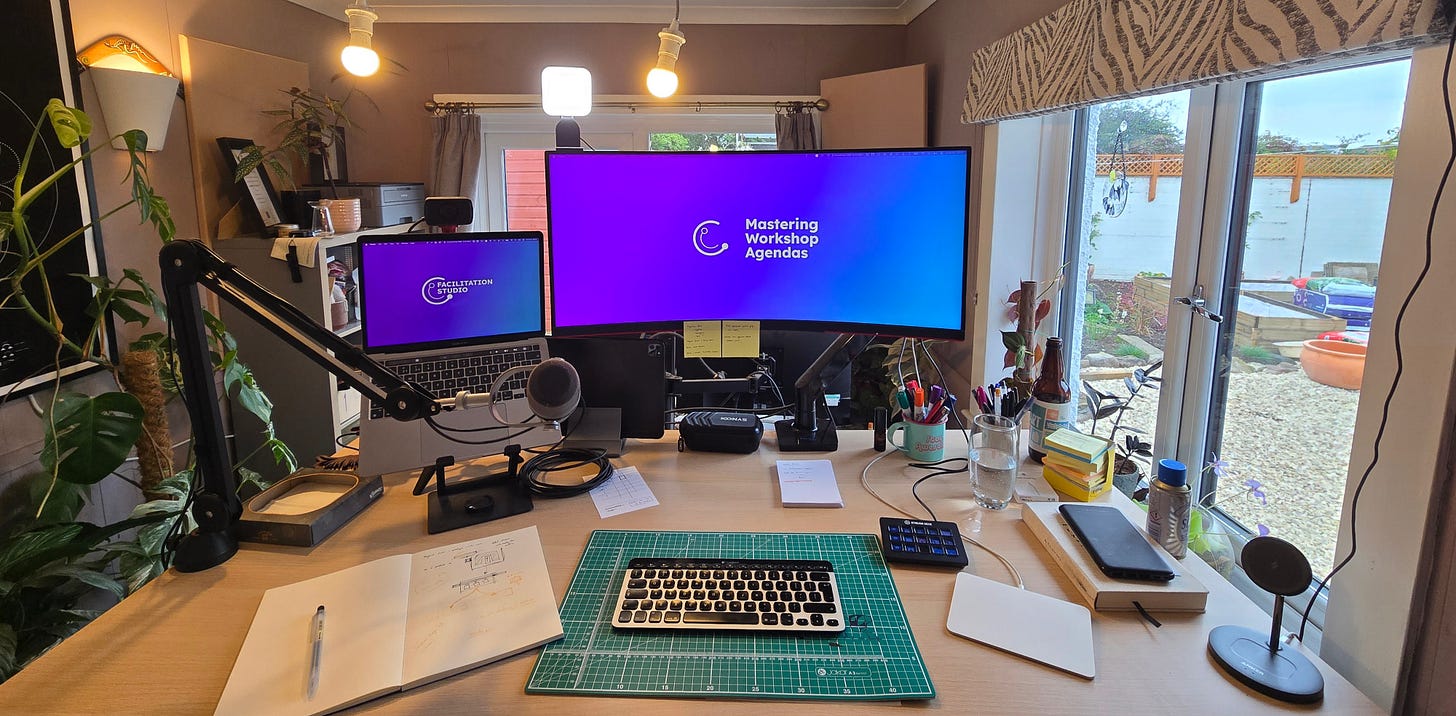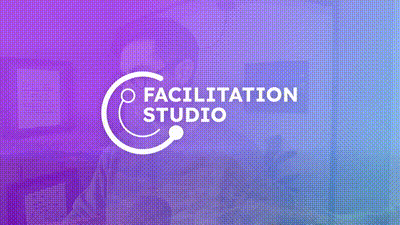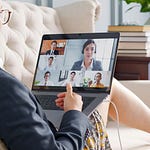Welcome back to the facilitation studio!
Today, we're discussing the practicalities of running a remote workshop. First, I'll give you a tour of my desk and how I set it up for a remote workshop. Then, we'll go through a checklist that covers most of the basic things I do before any remote session to ensure I'm setting myself up for success. I hope it's useful for you, too!
My setup
Okay, so let's start with a reality check. I'm a geek. I love techy things, and I do a lot of facilitation, so you don't need all of the kit I will run through. I'll talk about the essentials as we go and then call out the shiny things I've treated myself to and those I've got my eyes on.
Once again, you can run a fantastic workshop without gadgets. Gadgets make your life a bit easier.
The essentials (in order of priority!)
A printout of your agenda. Keep your agenda in sight at all times so you can keep your eyes on what's happening and note any deviations or changes. Don't let your agenda drift to the back of the hundreds of tabs you'll inevitably have open. Also, here's a smooth second plug. Did you know I'm running a course on designing great agendas? You can find out more on Maven.
A notepad or paper. I take notes constantly; it helps me think, but what’s really valuable is noting down any asides you’d like to come back to or questions that need follow-up. This helps you tie up all the loose ends as you move through a session.
A clock. I have a big red analogue clock on the wall next to my desk. I can easily glance at it to keep track of the time. I also use an app called Flip Clock that floats over all other windows. The clock in the corer of your computer is great, but vanishes way to often.
Two screens. You need two screens to see your collaborators and what you're working on simultaneously.
On one screen (the one with your camera above/near), I have a gallery view of my collaborators up at all times, so I can keep my eyes on who's paying attention and also look for facial expressions which might give some indication of if my message is landing. This is the screen with my camera because the movement of my head gives a super clear indication of when I'm talking to people vs looking at our shared work, which is a strong nonverbal indication of interest and engagement to my collaborators.
On the second screen (in my case the much bigger screen) I will have a presentation, if I'm using it, and whatever collaboration tool I'm using.
Microphone. Clear audio is the most important thing in a call. Bluetooth degrades audio, so I'd advocate for a wired one. I use the Shure MV7, which is the classic podcasting mic. It's directional, which is great for me as I share my office with my husband, and it avoids picking up too much of his voice if we're on calls simultaneously.
Ear/headphones. You need to hear what's going on around you! I use Shure SE215 PROs, which I've had since about 2009. I plug them directly into my microphone so I can mointer my own voice. I get loud when I'm excited about something, and for the same reason I have a direction mic, I need to spot when I'm shouting so I don't upset my partner! I also like that they're clear and fastened behind my head, so they're out of sight and not distracting visually.
Good lighting. This could be free (sit in front of that picture window) or a little more expensive, with hanging diffused bulbs in the right place or even getting a key light (at the moment I use the Logitech Litra Glow) or ring light for your setup. No matter how you do it, ensure you're in a bright space so your participants can see what's going on.
Camera. The webcams that come with most laptops are of great quality, but they're not very flexible in terms of positioning. I use an Elgato Facecam on a desk tripod. It means I can move it about for different things, and put it at different hights, without having to prop my laptop up in awkward spaces. The Elgato Facecam is also (reletivly) good in low light, so whilst I'm working on the lighting in my office it helps me step ahead a little.
The geeky gadgets
So this is absolutely non-essential stuff that I have, or want, and why it enhances my setup.
Microphone arms. It's really useful to get your mic up off your desk and make it easy to adjust when you move when required. I use the TONOR microphone boom arm because it has no external springs, which I've found can be squeaky sometimes.
iPad or other tablet. I currently use a big iPad Pro for note-taking and drawing live into events (doodles on whiteboards, etc.). I also use my iPad as my second screen sometimes if I'm travelling. But I really fancy the new reMarkable for this kind of thing.
OBS is an open-source tool for streamers that I use as a virtual camera when I'm in Zoom or Meet etc. It allows me to control my camera, merge other video sources (I have a second camera for overhead stuff), and incorporate presentations and screen shares into the video output.
Elgato Stream Deck. This is like a little external keyboard for custom buttons. I use it to control my OBS output and to skip through slides in presentations when that window isn't active, giving me more flexibility.
Teleprompter. This is the ultimate "want". A second screen I can use to make eye contact with collaborators when I'm talking to them, rather than looking a little off-screen. I've got my eyes on the Elgato one. (I get that this is extra, but... like I said. Geek.)
The checklist
And on to the checklist of actions to take, and things to be aware of. It is super tactical; it does not deal with designing the session but with the logistics of what you're making happen.
Pre-Workshop Planning
Choose the right tools for the job.
Select a reliable video conferencing platform (e.g., Zoom, Microsoft Teams, Google Meet). Honestly, I'm not loyal to one VC over another, but I am absolutely against Teams, and it never fails to trip me up. Zoom has the right amount of flexibility and is ubiquitous enough that most everyone can get on it immediately.
Choose a collaborative workspace tool like Figjam. Or Miro, Mural, Lucid... the list goes on. Working on a virtual whiteboard is super helpful. I use Figjam because I can design complex components in Figma and port them into Figjam, but that's no reason to break from whatever you're more comfortable with. Just remember that a whiteboard is a temporary surface, not somewhere to store things indefinitely.
Make sure they're accessible through you and your participant's IT systems.
There are some super cool facilitation-focused tools, like Butter.us, which if you can use, absolutely go for it. The key challenge is sneaking them through your business or client's IT systems if you're working in a corporate environment and covering the cost of accessing the platforms.
Design and create any necessary digital assets, presentations, or templates.
Make sure they're all accessible within your workspace tool.
Make sure they're a logical size, and people can navigate them on a 13" laptop screen
Ensure all tools work correctly and you're familiar with their features.
Participant Preparation
Send invitations with plenty of time. Do this before you do anything else, so you're blocking time in diaries.
Send a follow-up (or amend that cal invite) with the participant agenda, objectives, and any pre-work assignments.
Share guides on accessing and using the chosen tools. You'll also want to do a demo and a warm-up to get people engaging with them. Tools are scary.
Consider hosting a brief pre-workshop session to familiarise participants with the tools.
Day Before the Workshop
Send a reminder email: Include the agenda, joining links, and last-minute instructions.
Drink lots of water. You're going to be talking a lot into a microphone. Let's avoid those dehydrated mouth noises.
Day of the workshop
Do some personal care
Take some quiet time before your session, and make sure you have a break between any previous calls or meetings and your session
Make sure you have water and other drinks within reach
Make sure your lighting is as good as it can be
Ensure you're comfortable and that disruptions in your office/house are minimal.
Tech setup
Test your internet connection, camera, and microphone.
Join the session at least 15-20 minutes before the start time.
Display workshop title, agenda, and housekeeping notes as people join the call. I prefer to put these in the collaboration tool or use them as a virtual background for myself so I'm not sharing my screen and, therefore, isolating people from each other when they join the call.
Be ready with some chat and joy to fill the time whilst people filter into the call, or use a pre-show screen so everyone joins at once
Begin the session promptly, welcoming participants as they join.
Post-Workshop
Send follow-up emails to thank participants and share any relevant materials or recordings.
Distribute a survey to gather insights for improvement.
That list should help you set things up!
Remember that online workshops need you to be alert and constantly watch your participants. Draw in anyone who's been on mute for too long, and focus on keeping things dynamic.
As I mentioned earlier, I run a three-week course, which takes about 4 hours of your time per week, to help you design better workshops. Follow this link to the course on Maven.
OK. get to it!
Happy facilitating!








